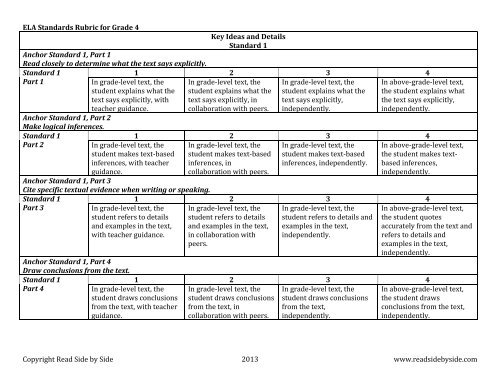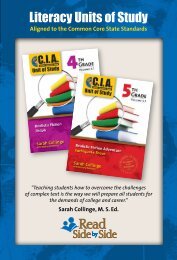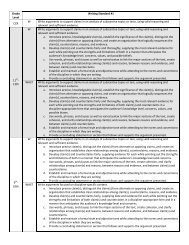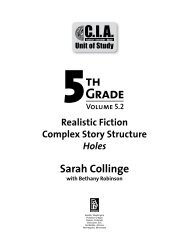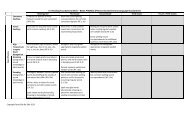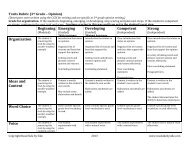4th Grade ELA Standards Rubric - Read Side By Side
4th Grade ELA Standards Rubric - Read Side By Side
4th Grade ELA Standards Rubric - Read Side By Side
You also want an ePaper? Increase the reach of your titles
YUMPU automatically turns print PDFs into web optimized ePapers that Google loves.
<strong>ELA</strong> <strong>Standards</strong> <strong>Rubric</strong> for <strong>Grade</strong> 4Key Ideas and DetailsStandard 1Anchor Standard 1, Part 1<strong>Read</strong> closely to determine what the text says explicitly.Standard 1Part 11 2 3 4Anchor Standard 1, Part 2Make logical inferences.Standard 1Part 2In grade-level text, thestudent explains what thetext says explicitly, withteacher guidance.In grade-level text, thestudent makes text-basedinferences, with teacherguidance.In grade-level text, thestudent explains what thetext says explicitly, incollaboration with peers.In grade-level text, thestudent explains what thetext says explicitly,independently.In above-grade-level text,the student explains whatthe text says explicitly,independently.1 2 3 4In grade-level text, the In grade-level text, thestudent makes text-based student makes text-basedinferences, ininferences, independently.collaboration with peers.In above-grade-level text,the student makes textbasedinferences,independently.Anchor Standard 1, Part 3Cite specific textual evidence when writing or speaking.Standard 1Part 31 2 3 4Anchor Standard 1, Part 4Draw conclusions from the text.Standard 1Part 4In grade-level text, thestudent refers to detailsand examples in the text,with teacher guidance.In grade-level text, thestudent draws conclusionsfrom the text, with teacherguidance.In grade-level text, thestudent refers to detailsand examples in the text,in collaboration withpeers.In grade-level text, thestudent refers to details andexamples in the text,independently.In above-grade-level text,the student quotesaccurately from the text andrefers to details andexamples in the text,independently.1 2 3 4In grade-level text, the In grade-level text, thestudent draws conclusions student draws conclusionsfrom the text, infrom the text,collaboration with peers. independently.In above-grade-level text,the student drawsconclusions from the text,independently.Copyright <strong>Read</strong> <strong>Side</strong> by <strong>Side</strong> 2013 www.readsidebyside.com
<strong>ELA</strong> <strong>Standards</strong> <strong>Rubric</strong> for <strong>Grade</strong> 4Key Ideas and DetailsStandard 2Anchor Standard 2, Part 1Determine central ideas and themes and analyze their development.Standard 2Part 11 2 3 4The student determines acentral idea or theme ofgrade-level text, withteacher guidance.The student determines acentral idea or theme ofgrade-level text, incollaboration with peers.The student determines acentral idea or theme ofgrade-level text,independently.The student determines acentral idea or theme andanalyzes its development inabove-grade-level text,independently.Anchor Standard 2, Part 2Summarize the key supporting details and ideas.Standard 2Part 21 2 3 4The student summarizesgrade-level text, withteacher guidance.The student summarizesgrade-level text, incollaboration with peers.The student summarizesgrade-level text,independently.The student summarizesabove-grade-level text,independently.Copyright <strong>Read</strong> <strong>Side</strong> by <strong>Side</strong> 2013 www.readsidebyside.com
<strong>ELA</strong> <strong>Standards</strong> <strong>Rubric</strong> for <strong>Grade</strong> 4Key Ideas and DetailsStandard 3Anchor Standard 3Analyze how and why individuals, events, and ideas develop and interact over the course of the text.Standard 31 2 3 4Describe in depth acharacter, setting,or event, drawingon specific detailsin the text (e.g., acharacter’sthoughts, words,and actions).In grade-level text, thestudent describes in deptha character, setting, orevent, with teacherguidance.In grade-level text, thestudent describes in deptha character, setting, orevent, in collaborationwith peers.In grade-level text, thestudent describes in depth acharacter, setting, or event,independently.Standard 3Compare andcontrast two ormore characters,settings, or events,drawing on specificdetails in the text.Standard 3Describe how thecharacters respondor change as theplot moves towarda resolution.In above-grade-level text,the student describes indepth a character, setting, orevent, independently.1 2 3 4In grade-level text, thestudent compares andcontrasts two or morecharacters, settings, orevents, with teacherguidance.In grade-level text, thestudent compares andcontrasts two or morecharacters, settings, orevents, in collaboration withpeers.In grade-level text, thestudent compares andcontrasts two or morecharacters, settings, orevents, independently.1 2 3 4In grade-level text, thestudent describes how thecharacters respond orchange as the plot develops,with teacher guidance.In grade-level text, thestudent describes how thecharacters respond orchange as the plot develops,in collaboration with peersor independently.Copyright <strong>Read</strong> <strong>Side</strong> by <strong>Side</strong> 2013 www.readsidebyside.com
<strong>ELA</strong> <strong>Standards</strong> <strong>Rubric</strong> for <strong>Grade</strong> 4Craft and StructureStandard 4Anchor Standard 4, Part 1Interpret words and phrases as they are used in a text.Standard 4Part 11 2 3 4The student determines themeaning of words andphrases in grade-level text,with teacher guidance.The student determinesthe meaning of words andphrases in grade-leveltext, in collaboration withpeers.The student determines themeaning of words andphrases in grade-level text,independently.The student determines themeaning of words andphrases in above-gradeleveltext, independently.Anchor Standard 4, Part 2Interpret figurative meanings as they are used in the text.Standard 41 2 3 4Part 2Determine themeaning of nonliteralandfigurativelanguage.The student determinesthe meaning of non-literaland figurative language ingrade-level text, withteacher guidance.The student determines themeaning of non-literal andfigurative language ingrade-level text, incollaboration with peers.The student determines themeaning of non-literal andfigurative language ingrade-level text,independently.Anchor Standard 4, Part 3Analyze how specific words shape meaning and tone.Standard 4Part 31 2 3 4The student analyzes theimpact of a specific wordchoice on meaning and tonein grade-level text, withteacher guidance.The student analyzes theimpact of a specific wordchoice on meaning and tonein grade-level text, incollaboration with peers orindependently.Copyright <strong>Read</strong> <strong>Side</strong> by <strong>Side</strong> 2013 www.readsidebyside.com
<strong>ELA</strong> <strong>Standards</strong> <strong>Rubric</strong> for <strong>Grade</strong> 4Craft and StructureStandard 5Anchor Standard 5Analyze the structure of texts, including how specific sentences, paragraphs, and larger portions of the text relate to each other andthe whole.Standard 5Explain how aseries of chapters,scenes, or stanzasfits together toprovide the overallstructure of a text.1 2 3 4The student explains how The student explains how aa series of chapters, series of chapters, scenes, orscenes, or stanzas fits stanzas fits together totogether to provide the provide the overalloverall structure of a structure of a grade-levelgrade-level text, with text, in collaboration withteacher guidance.peers.The student explains how aseries of chapters, scenes, orstanzas fits together toprovide the overallstructure of a grade-leveltext, independently.Copyright <strong>Read</strong> <strong>Side</strong> by <strong>Side</strong> 2013 www.readsidebyside.com
<strong>ELA</strong> <strong>Standards</strong> <strong>Rubric</strong> for <strong>Grade</strong> 4Craft and StructureStandard 6Anchor Standard 6Assess how point of view or purpose shapes the content and style of the text.Standard 61 2 3 4Distinguish one’sown point of viewfrom that of thenarrator/author orthose of thecharacters.In grade-level text, thestudent distinguishes his orher own point of view fromthat of the narrator/authoror those of the characters,with teacher guidance.In grade-level text, thestudent distinguishes hisor her own point of viewfrom that of thenarrator/author or thoseof the characters, inIn grade-level text, thestudent distinguishes his orher own point of view fromthat of the narrator/authoror those of the characters,independently.Standard 6Compare andcontrast the pointsof view from whichdifferent stories arenarrated.Standard 6Describe how anarrator’s orspeaker’s point ofview influenceshow events aredescribed.In grade-level text, thestudent compares andcontrasts the points of viewfrom which differentstories are narrated, withteacher guidance.In above-grade-level text,the student distinguishes hisor her own point of viewfrom that of thenarrator/author or those ofthe characters,collaboration with peers.independently.1 2 3 4In grade-level text, the In grade-level text, thestudent compares and student compares andcontrasts the points of contrasts the points of viewview from which different from which different storiesstories are narrated, in are narrated, independently.collaboration with peers.In above-grade-level text,the student compares andcontrasts the points of viewfrom which different storiesare narrated, independently.1 2 3 4In grade-level text, thestudent describes how anarrator’s or speaker’spoint of view influenceshow events are described,with teacher guidance.In grade-level text, thestudent describes how anarrator’s or speaker’s pointof view influences howevents are described, incollaboration with peers.In grade-level text, thestudent describes how anarrator’s or speaker’s pointof view influences howevents are described,independently.Copyright <strong>Read</strong> <strong>Side</strong> by <strong>Side</strong> 2013 www.readsidebyside.com
<strong>ELA</strong> <strong>Standards</strong> <strong>Rubric</strong> for <strong>Grade</strong> 4Integration of Knowledge and IdeasStandard 7Anchor Standard 7Integrate and evaluate content presented in diverse media formats, including visually and quantitatively, as well as in words.Standard 71 2 3 4Analyze how visualand multimediaelementscontribute to themeaning, tone, orbeauty of a text.The student analyzes howinformation from outsidesources (including visualand multimedia elements)contribute to a grade-leveltext, with teacherguidance.The student analyzes howinformation from outsidesources (including visualand multimedia elements)contribute to a grade-leveltext, in collaboration withpeers.The student analyzes howinformation from outsidesources (including visualand multimedia elements)contribute to a grade-leveltext, independently.Copyright <strong>Read</strong> <strong>Side</strong> by <strong>Side</strong> 2013 www.readsidebyside.com
<strong>ELA</strong> <strong>Standards</strong> <strong>Rubric</strong> for <strong>Grade</strong> 4Integration of Knowledge and IdeasStandard 8*This standard will be assessed in historical fiction, science fiction, narrative nonfiction.Anchor Standard 8, Part 1Delineate the argument in a text.Standard 81 2 3 4Part 1The student explains how The student explains how The student explains howExplain how an an author uses reasons and an author uses reasons an author uses reasons andauthor uses evidence to support and evidence to support evidence to supportreasons and particular claims in gradelevelparticular claims in grade-particular claims in grade-evidence to supporttext, with teacher level text, in collaboration level text, independently.particular claims. guidance.with peers.The student explains howan author uses reasons andevidence to supportparticular claims in abovegrade-leveltext,independently.Anchor Standard 8, Part 2Evaluate the argument and specific claims in a text, including the validity of reasoning as well as the relevance and sufficiency ofevidence.Standard 8Part 2Evaluate theargument andspecific claims in atext, distinguishingclaims that aresupported byreasons andevidence.1 2 3 4The student evaluates theargument and specificclaims in a text, with teacherguidance.The student evaluates theargument and specificclaims in a text, incollaboration with peers orindependently.Copyright <strong>Read</strong> <strong>Side</strong> by <strong>Side</strong> 2013 www.readsidebyside.com
<strong>ELA</strong> <strong>Standards</strong> <strong>Rubric</strong> for <strong>Grade</strong> 4Integration of Knowledge and IdeasStandard 9Anchor Standard 9Analyze how two or more texts address similar themes or topics in order to build knowledge or to compare the approaches similar authors take.Standard 91 2 3 4Compare andcontrast thetreatment ofsimilar themes,topics, andpatterns of events(e.g. the quest).The student compares andcontrasts themes, topics,and patterns of events, intwo or more grade-leveltexts, with teacherguidance.The student compares andcontrasts themes, topics,and patterns of events, intwo or more grade-leveltexts, in collaboration withpeers.The student compares andcontrasts themes, topics,and patterns of events, intwo or more grade-leveltexts, independently.The student compares andcontrasts themes, topics,and patterns of events, intwo or more above-gradeleveltexts, independently.Standard 9Compare andcontrast stories inthe same genre interms of theirapproaches tosimilar themes/topics.Standard 9Compare andcontrast texts indifferent genres interms of theirapproaches tosimilar themes/topics.Standard 9Compare andcontrast a fictionalportrayal of a timeand a historicalaccount of thesame period.1 2 3 4The student compares andcontrasts grade-levelstories in the same genre,with teacher guidance.The student compares andcontrasts grade-level storiesin the same genre, incollaboration with peers.The student compares andcontrasts grade-level storiesin the same genre,independently.1 2 3 4The student compares andcontrasts grade-level textsin different genres, withteacher guidance.The student compares andcontrasts grade-level textsin different genres, incollaboration with peers orindependently.1 2 3 4The student compares andcontrasts a fictionalportrayal and a historicalaccount, or a primary and asecondary source, withteacher guidance, or incollaboration with peers.Copyright <strong>Read</strong> <strong>Side</strong> by <strong>Side</strong> 2013 www.readsidebyside.com
<strong>ELA</strong> <strong>Standards</strong> <strong>Rubric</strong> for <strong>Grade</strong> 4Range of <strong>Read</strong>ing and Level of Text ComplexityStandard 10Anchor Standard 10<strong>Read</strong> and comprehend complex literary text independently and proficiently.Standard 10 1 2 3 4The student reads andcomprehends literature inthe lower to middle, grade4–5 text complexity band,with teacher guidance.The student reads andcomprehends literature inthe lower to middle, grade4–5 text complexity band,in collaboration withpeers.The student reads andcomprehends literature inthe lower to middle, grade4–5 text complexity band,independently.The student reads andcomprehends literature inthe upper, grade 4–5 textcomplexity band, or higher,independently.Copyright <strong>Read</strong> <strong>Side</strong> by <strong>Side</strong> 2013 www.readsidebyside.com


